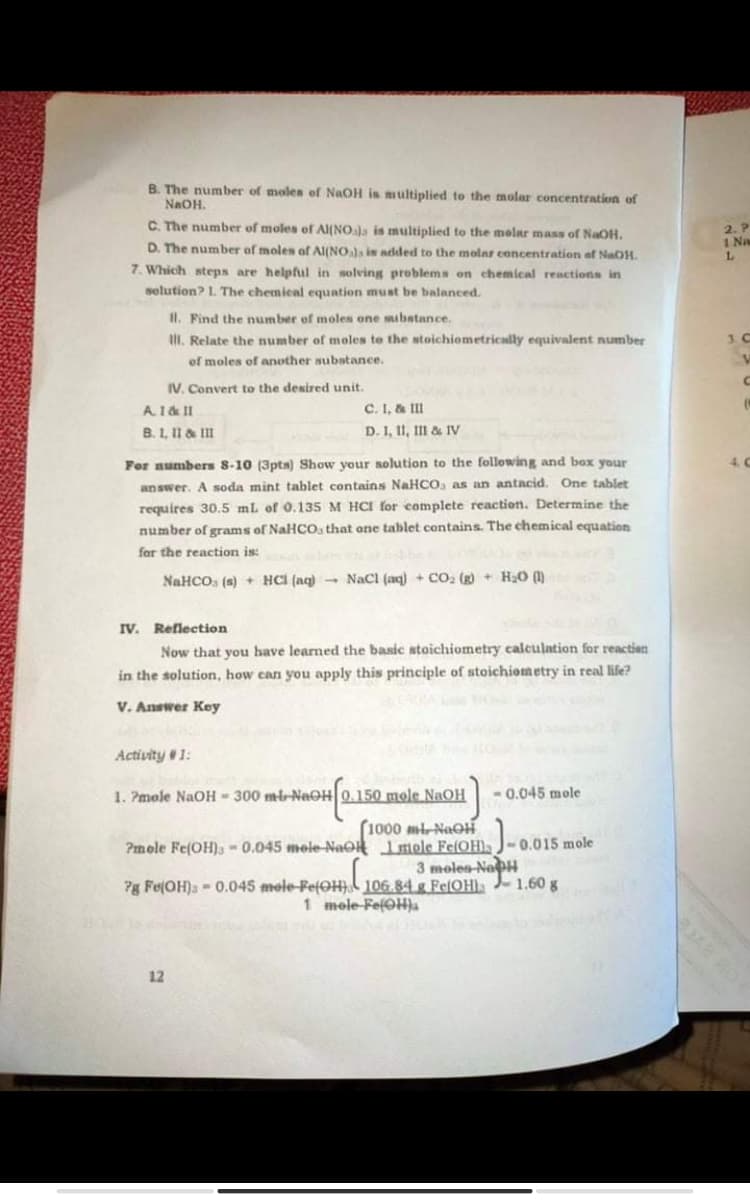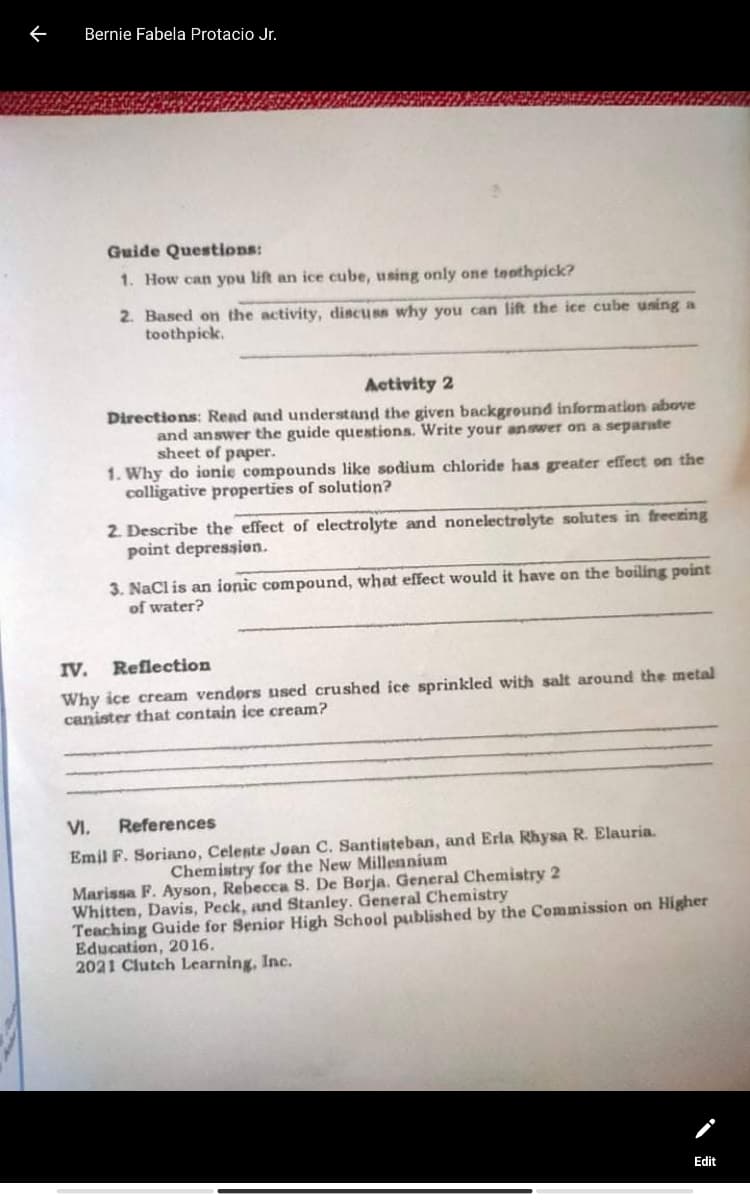solution? 1. The chemical equation must be balanced. II. Find the number of moles one mubatance. II. Relate the number of moles te the stoichiometrically equivalent of moles of another subatance. IV. Convert to the desired unit
solution? 1. The chemical equation must be balanced. II. Find the number of moles one mubatance. II. Relate the number of moles te the stoichiometrically equivalent of moles of another subatance. IV. Convert to the desired unit
Chemistry: Matter and Change
1st Edition
ISBN:9780078746376
Author:Dinah Zike, Laurel Dingrando, Nicholas Hainen, Cheryl Wistrom
Publisher:Dinah Zike, Laurel Dingrando, Nicholas Hainen, Cheryl Wistrom
Chapter11: Stoichiometry
Section: Chapter Questions
Problem 108A: Apply Students conducted a lab to investigate limiting and excess reactants. The students added...
Related questions
Question

Transcribed Image Text:B. The number of moles ef NaOH is multiplied to the molar concentration of
NAOH.
C. The number of moles of Al(NOs is multiplied to the molar mass of NaOH.
D. The number of moles of AI(NO)s is added to the molat concentration af NaOH.
2. P
1 Na
L.
7. Which steps are helpful in solving problems on chemical reactions in
solution? L. The chemical equation must be balanced.
II. Find the number of moless one mibatance.
3. C
II. Relate the number of moles te the stoichiometrically equivalent number
of moles of another subatance.
IV. Convert to the desired unit.
C. I, & III
D. I, II, III & IV
Al& II
B. I, I1 & II
For numbers 8-10 (3pts) Show your solution to the following and box your
answer. A soda mint tablet contains NaHCO, as an antacid. One tablet
requires 30.5 mL of 0.135 M HCI for complete reaction. Determine the
number of grams of NaHCo, that one tablet contains. The chemical equation
for the reaction is:
NaHCO, (s) + HCI (aq) - NaCl (aq) + CO2 (g) + H2O (1)
IV. Reflection
Now that you have learned the basic stoichiometry calculation for reaction
in the solution, how can you apply this principle of stoichiometry in real life?
V. Answer Key
Activity 1:
1. Pmole NaOH = 300 mb-NaOH 0.150 mole NaOH
- 0.045 mole
(1000 mt-Naoi
Pmole Fe(OH)3 - 0.045 mele NAOH 1mole Fe(OH), J-0.015 mole
3 moles-NaH
7g Fe(OH)3-0.045 mele Fe(OH 106.84 g FelOHI, - 1.60 g
1 mele FefOH)a
12

Transcribed Image Text:Bernie Fabela Protacio Jr.
Guide Questions:
1. How can you lift an ice cube, using only one teothpick?
2. Based on the activity, discuss why you can lift the ice cube using a
toothpick.
Activity 2
Directions: Read and understand the given background information above
and answer the guide questions. Write your answer on a separate
sheet of paper.
1. Why do ionie compounds like sodium chloride has greater effect on the
colligative properties of solution?
2. Describe the effect of electrolyte and nonelectrolyte solutes in freezing
point depression.
3. NaCl is an ionic compound, what effect would it have on the boiling point
of water?
IV. Reflection
Why ice cream vendors used crushed ice sprinkled with salt around the metal
canister that contain ice cream?
VI.
References
Emil F. Soriano, Celente Joan C. Santisteban, and Erla Rhysa R. Elauria.
Chemistry for the New Milleanium
Marissa F. Ayson, Rebecca S. De Borja. General Chemistry 2
Whitten, Davis, Peck, and Stanley. General Chemistry
Teaching Guide for Senior High School published by the Commission on Higher
Education, 2016.
2021 Clutch Learning, Inc.
Edit
Expert Solution
This question has been solved!
Explore an expertly crafted, step-by-step solution for a thorough understanding of key concepts.
Step by step
Solved in 2 steps with 2 images

Knowledge Booster
Learn more about
Need a deep-dive on the concept behind this application? Look no further. Learn more about this topic, chemistry and related others by exploring similar questions and additional content below.Recommended textbooks for you

Chemistry: Matter and Change
Chemistry
ISBN:
9780078746376
Author:
Dinah Zike, Laurel Dingrando, Nicholas Hainen, Cheryl Wistrom
Publisher:
Glencoe/McGraw-Hill School Pub Co

Introductory Chemistry: A Foundation
Chemistry
ISBN:
9781337399425
Author:
Steven S. Zumdahl, Donald J. DeCoste
Publisher:
Cengage Learning

Chemistry
Chemistry
ISBN:
9781305957404
Author:
Steven S. Zumdahl, Susan A. Zumdahl, Donald J. DeCoste
Publisher:
Cengage Learning

Chemistry: Matter and Change
Chemistry
ISBN:
9780078746376
Author:
Dinah Zike, Laurel Dingrando, Nicholas Hainen, Cheryl Wistrom
Publisher:
Glencoe/McGraw-Hill School Pub Co

Introductory Chemistry: A Foundation
Chemistry
ISBN:
9781337399425
Author:
Steven S. Zumdahl, Donald J. DeCoste
Publisher:
Cengage Learning

Chemistry
Chemistry
ISBN:
9781305957404
Author:
Steven S. Zumdahl, Susan A. Zumdahl, Donald J. DeCoste
Publisher:
Cengage Learning

Principles of Modern Chemistry
Chemistry
ISBN:
9781305079113
Author:
David W. Oxtoby, H. Pat Gillis, Laurie J. Butler
Publisher:
Cengage Learning

Chemistry: An Atoms First Approach
Chemistry
ISBN:
9781305079243
Author:
Steven S. Zumdahl, Susan A. Zumdahl
Publisher:
Cengage Learning
